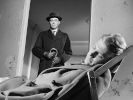Eye For Film >> Movies >> The Servant (1963) DVD Review

Studiocanal's Collector's Edition Blu-ray is well worth the investment. Spread across two discs, the first contains the film in both 1.66 and 1.77 aspect ratios, a choice that may be for aficionados only, although the 4K restoration has been beautifully done. Given how much of the film's atmosphere relies on its chiaroscuro lighting and sound design, the scrubbing up of these adds immeasurably to the viewing experience. An example of just how murky previous prints of the film have become can be seen among the plentiful extras on the release's second disc, with excerpts show in a New York Film Festival discussion from the first edition of the festival in 1963.
Even that was shot with an eye for aesthetics, as Losey, along with Hallelujah The Hills director Adolfas Mekas talk to the festival's co-ordinator Amos Vogel and co-founder Richard Roud. It's a Very Serious but interesting chat as much for the snapshot of cinema at the time as it is The Servant itself. Losey notes that "people are dying for film" and is overjoyed that this one wasn't "tampered with". They also note how wonderful it is that 80 per cent of those in the NYFF audience - full houses, by the way - were "people under 25 years of age", something I doubt that can be said in the modern world. To break up the chat, the camera occasionally drifts forward to focus on Jim Macandrew who fills in details about the directors' films. All in all, a retro treat.

Also from the archive comes a short interview with Losey about the film in which he, again, notes how pleased he was to be able to make it "without interference" along with an ITV arts show - remember those? - in which Harold Pinter's biography and work are highlighted and the writer is interviewed. It's hard to imagine The One Show even having someone like Pinter on, let alone daring to ask them whether their work is a bit "obscure" but that happens here. Pinter takes it all in good grace, noting that while his characters are "all to do with me, one way or another.. it's an activity that I simply can't explain. I just do it." Topics touched on include his conscientious objection to national service and his confrontations with Fascists in Hackney. There's also a chunk of 1973 TV play The Homecoming featuring a young Ian Holm and Vivien Merchant among others.
There's a wealth of first-person recollection here, too including Richard Ayoade interviewing James Fox, who plays the wealthy and dissolute Tony. Ayoade is a serious cinephile and happily digs into the themes of the film with Fox, although the actor's memories of being on the set seem a bit hazy and he often, instead, mentions things he's read that Dirk Bogarde said about the film. It is interesting to note that he got picked, or at least pushed forward, for the job by Sarah Miles, who plays Vera and was his real-life girlfriend at the time and who said she wouldn't take the part unless he was considered. Losey's manner of considering him was to do some test filming while plying him with alcohol, which doesn't sound like a bad day's work. Ayoade has a slightly rambling style - something he himself draws attention to - but his observations are often as interesting as Fox's answers.
More to the point are shorter interviews with Wendy Craig, who plays Tony's girlfriend Susan and Miles. Craig offers some lovely anecdotes about her time on the set, in particular, noting how kind Bogarde was. Miles, meanwhile, recalls how shocked her family were when they first saw the film, only coming round after the reviews were in.
Beyond the first-person extras is more academic fare, including a new location featurette with Adam Sovell, which is mildly interesting but not much more than that and a video essay, Dirkology, with critics Matthew Sweet and Phuong Le that digs into some of the film's ideas in more detail. In addition, there's more observations on Bogarde from his biographer John Coldstream, an audio interview with cinematographer Douglas Slocombe, who talks about some of the film's more tricky shots - particularly that all important convex mirror,. The final two interviews, see Working With Pinter director Harry Burton offer some thoughts on the writer and Carol producer Stephen Woolley offer more thoughts on the film, but these feel more like padding than anything else.
Rounding out the set is a curious trailer, which hinges on a speech Bogarde makes late in the film, and a lovely stills gallery of 27 on-set photos. All in all this is a pretty exhaustive and consistently solid set of extras that almost all offer additional things to think about in respect of the film and its craft.
Reviewed on: 22 Sep 2021















